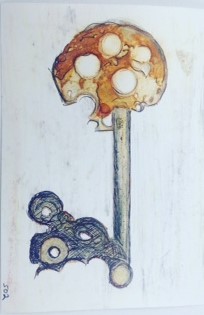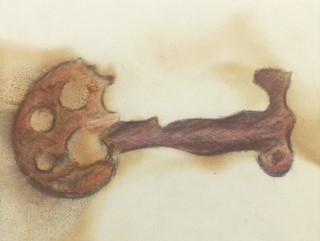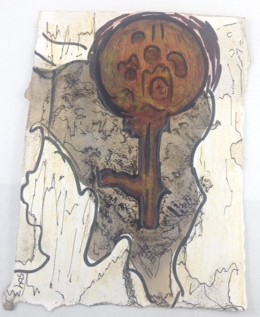Keys 501 - 510 from Ten Keys Ten Ways
Since beginning this project I've thought about making "Ten Keys Ten Ways". This is my first experiment in doing that. Last summer I read a magazine article about making prints from rusty objects and various liquids and thought I'd try that. I started out by making ten "keys" out of some rusty bits I bought at an estate sale. Then I experimented with various liquids on a variety of papers.

Here's a key and three prints that I made from it:
Here's the first key that I made ten ways:
For Key 501 I used two bolts and a really cool looking piece of metal that I have no idea what it's a part for. I loosely glued the pieces together when I was making the prints. Once the prints were done I glued the "key" onto the front of a glass picture frame and covered the entire thing in eco-friendly resin.
Key 502 is made with vinegar on Yupo paper. Yupo paper is entirely cool! It's described as "100% recyclable, waterproof, tree-free Synthetic Paper". I like it because it's super smooth. It's easy to emboss and tear resistant. I will be using this paper again sometime later on this key journey. After the print dried I drew on it with marker and pencil crayon. I'm OK with the finish on this piece but just OK - my drawing skills are out of shape so I don't think it looks that great - other than the rusty print part - I love that! But I've always been a sucker for rust.
Key 503 was made with vinegar on an old bed sheet (cotton/polyester material). I used conte crayon on this one. Not only did my drawing skills leave me wanting my photography skills (or lack thereof) were very tested on these prints. I just couldn't seem to get a clear focus on any of the keys. These are actually the second set of photos I took; the ones I took earlier were just too blurry. I'm a firm believer in not letting the perfect be the enemy of the good and I do want to get on with key making so...
Key 504 is made with Holiday Chai tea on Stonehenge paper. The Chai tea was very successful in making a strong rust print. It was curious that the tea turned black after it came into contact with the rust. Once this print was dry I used a black marker and a gold pen to heighten the key image.
Key 505 is made with onion and salt water on Bristol Board. When I was in the middle of making the prints I attended an art opening and one of the artists there suggested boiling onions in water. This made an interesting water colour but didn't really make a rust print; I had also added salt to the water (because I wasn't confident that I'd get a reaction from the onion water). I think it was the salt that did the work. I used some conte crayon to emphasize the key.
Key 506 is made with Santa's Secret tea on rice paper. I really like the way the tea and rice paper worked together. I also used some conte crayon on this print.
Key 507 is made with cranberry tea and vinegar on Arches 88 (a watercolour paper). The tea didn't really work so I added some vinegar. I also drew on this print with conte crayon.
Key 508 is made with vinegar on parchment paper (the kind used for cooking - the white lines are the watermarks from the parchment paper). This paper is translucent; the print looks great with a light behind it. I couldn't get a picture of that so you'll just have to take my word it looks cool. This print also has some conte crayon.
Key 509 is made with green tea on sketch paper. This tea turned intensely black when it came into contact with the rust (which is kind of surprising because the tea itself was a light green). I added pencil crayon and black marker to this print - neither of which are very visible even in real life.
Key 510 is made with bleach on black velvet and a bit of chalk to increase the highlight. I like the ghostly impression of this one.












